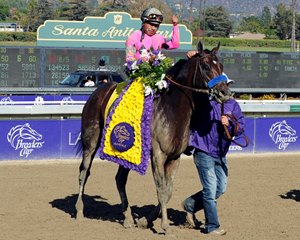New Race-Day Lasix Ban Could Revive Previous Efforts


The announcement April 18 by a coalition of racetrack operators to ban the race-day use of furosemide in 2-year-olds in 2020 and all stakes contenders in 2021 could breathe new life into previous, short-lived efforts to curb the medication's use.
In 2011, the American Graded Stakes Committee announced a pilot program that would have banned race-day furosemide in all graded stakes for juveniles. The decision came on the heels of a judgment by Breeders' Cup Limited to eliminate the medication, branded as Salix but known more commonly as Lasix, in all of its championship races for juveniles.
The Breeders' Cup ban in its juvenile races was implemented in 2012-13 but was abandoned for the 2014 championships. The AGSC, however, never implemented the broader race-day ban on all juvenile graded stakes.
"In 2011, it appeared there was a consensus among several groups that this was the right thing to do," said Dr. J. David Richardson, who is chairman of the Thoroughbred Owners and Breeders Association, which oversees the AGSC, and was AGSC chairman at the time.
"That disappeared as soon as things started to get a little rough, and everyone backed away. The American Graded Stakes Committee was standing alone without any real cooperative effort. As an organization, we don't want to be out there alone again, and that does not appear to be the case now," Richardson said.
The new initiative to phase out race-day Lasix is supported by the operators of 20 racetracks across the United States. By 2021, they have stated they will prohibit the medication in their listed and graded stakes. These racetracks run 86% of all listed and graded stakes offered.
With the new policy also supported by TOBA, Breeders' Cup, the AGSC, and the Kentucky Thoroughbred Association, the door seems open for AGSC to implement its vision from 2011 across all listed and graded stakes.
Neither Richardson nor Andy Schweigardt, TOBA director of industry relations and AGSC secretary, however, could say yet when such a change might be made.
"The committee will consider making a change to eligibility requirements and is encouraged by the broad support," Schweigardt said. "But as of now, nobody knows how this is going to play out from a regulatory standpoint."
"There is no question racing has an image problem. The Triple Crown and the Derby are coming up, and I applaud the tracks for doing something in a collaborative manner," Richardson said. "As far as the American Graded Stakes Committee is concerned, it wants to work with others and be part of the solution, but there are things we don't know. There might be some regulatory issues involved from different states that is yet to be determined.
"This is a different time, and hopefully there will be some synergies on a lot of things that will improve the perception of our sport."
The collaboration among the major tracks means more straightforward changes for Breeders' Cup.
"Breeders' Cup is not a racing association. We don't have a license to conduct racing, so the rules of the road have to be those implemented by the stewards at the host track," said Breeders' Cup president Craig Fravel. "Having said that, we have implemented variations on rules, such as the out-of-competition testing rule in California. We actually brought that rule forward."
State law allows associations to implement more stringent rules in conjunction with an agreement with the horseman's group.
"We are happy under these new rules," Fravel continued. "Breeders' Cup continues to be interested in conducting its races medication-free. That hasn't changed. What's important is that every major racetrack across the United States, the places where we run our events, are all on the same page. That gives much more strength to the effort."
